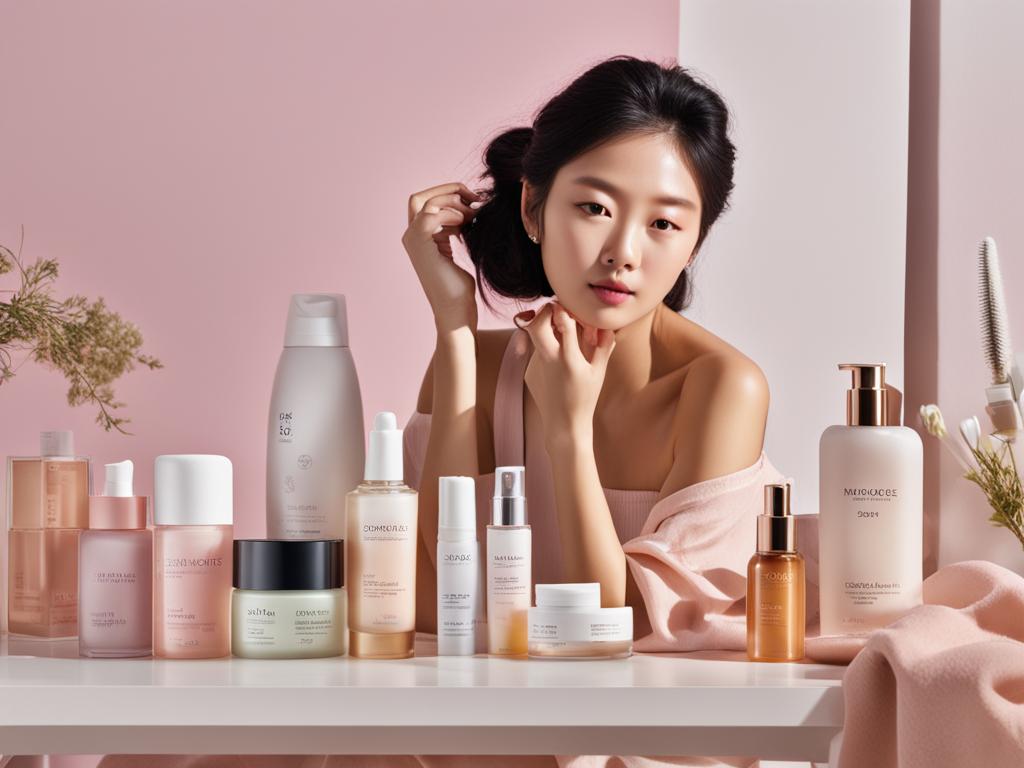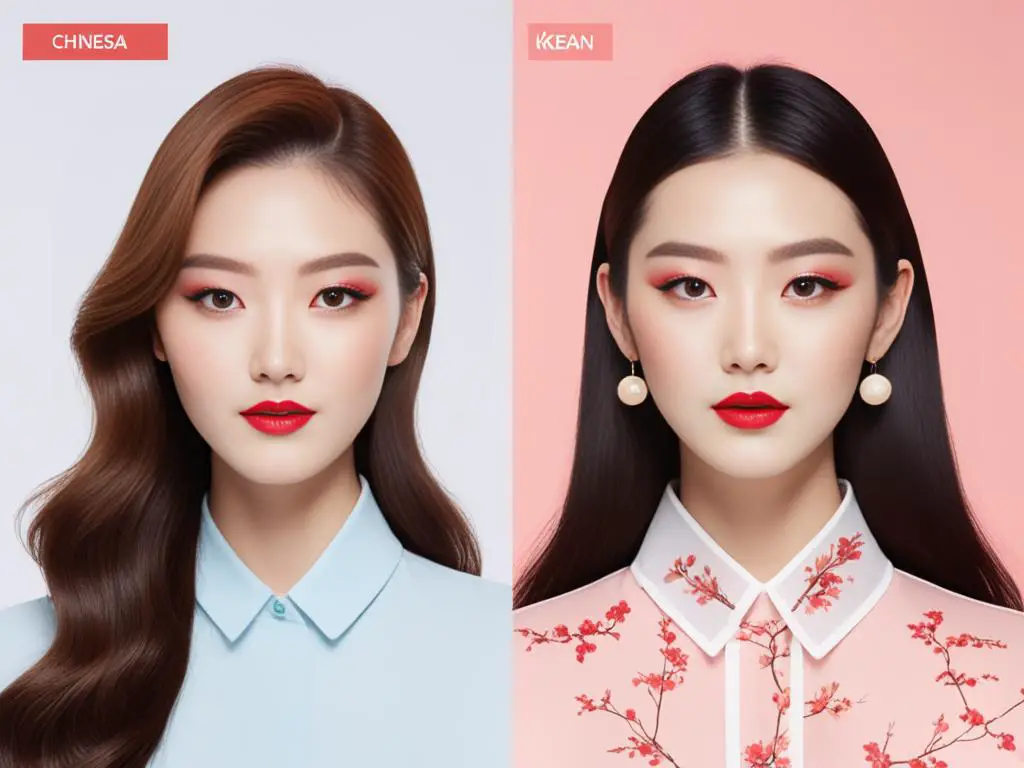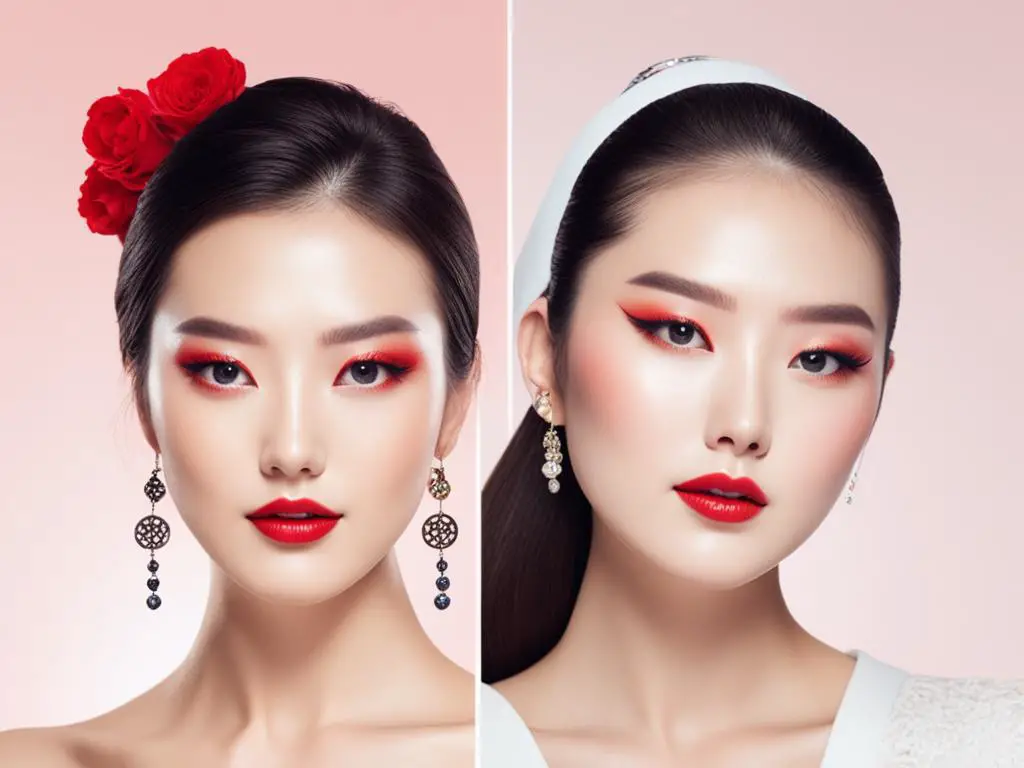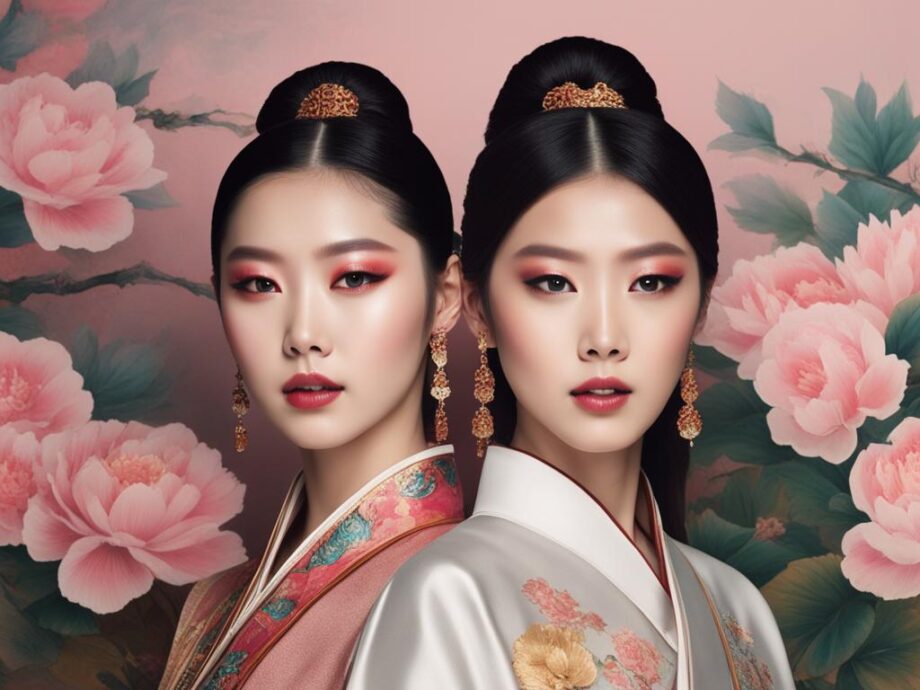Welcome to our in-depth exploration of Chinese vs Korean makeup! In this article, we will delve into the fascinating world of Asian cosmetics to uncover the trends and differences between these two beauty powerhouses. By understanding the cultural influences that shape beauty preferences in China and Korea, we can gain valuable insights into their unique makeup styles and techniques.
With Chinese and Korean beauty trends making waves worldwide, it’s essential to stay informed about the latest cosmetic innovations and cultural beauty norms. So, whether you’re an avid makeup enthusiast or simply looking to expand your beauty knowledge, this article is for you.
Key Takeaways:
- Chinese and Korean makeup have distinct styles and techniques influenced by cultural preferences.
- Asian cosmetics industry is booming, with both China and Korea contributing to the global market.
- China boasts C-beauty, which combines traditional ingredients with modern innovations.
- Korea is renowned for K-beauty, emphasizing skincare routines and natural, dewy makeup looks.
- Understanding the differences between Chinese and Korean makeup can enhance your beauty knowledge and inspire new looks.
Beauty Standards in China and Korea
In Asia, beauty standards play a significant role in shaping makeup preferences. China and Korea, two influential countries in the region, have their unique beauty ideals that greatly impact the cosmetics industry and individual’s choices. While both countries emphasize cultivating a flawless complexion and accentuating specific facial features, there are distinct differences in their preferred makeup looks.
Chinese Beauty Standards
Chinese beauty standards prioritize a fair and porcelain complexion, signifying purity and elegance. The concept of “亮白” (liang bai), meaning bright and white, is highly valued in Chinese culture. To achieve this ideal, Chinese individuals often focus on using products that lighten their skin tone, such as CC creams, brightening serums, and whitening moisturizers.
Furthermore, Chinese beauty standards emphasize enhancing specific facial features for a balanced and harmonious look. Bright, wide eyes are desirable, leading to the popularity of eyelash extensions and elaborate eyeliner techniques. Plump, rosy lips are also considered attractive, encouraging the use of lip tints and moisturizing lip masks.
Korean Beauty Standards
Korean beauty standards place great emphasis on achieving a flawless, youthful complexion with a natural glow. The concept of “chok chok” refers to dewy, glass-like skin that radiates health and vitality. To attain this coveted look, Korean individuals follow strict skincare routines that involve multiple steps and include products like essences, serums, and sheet masks.
In terms of makeup, Koreans favor a soft, fresh-faced aesthetic known as “no-makeup makeup.” This look focuses on creating a natural appearance by using minimal products and neutral tones. Subtle eye makeup, gradient lip colors, and natural-looking blush are commonly seen in Korean beauty trends.
| Chinese Beauty Standards | Korean Beauty Standards |
|---|---|
| Fair and porcelain complexion | Flawless and youthful glow |
| Emphasis on bright, wide eyes | Soft, natural eye makeup |
| Desire for plump, rosy lips | Gradient lip colors |
| Preference for lightening products | Rigorous skincare routines |
Distinctive Makeup Preferences
These contrasting beauty standards in China and Korea result in different makeup preferences. While Chinese individuals focus on achieving a fair complexion and accentuating their eyes and lips, Koreans prioritize a natural, glowing complexion and subtle makeup looks.
Chinese beauty standards emphasize a more pronounced and defined appearance, whereas Korean beauty standards strive for a more youthful and understated look.
Ultimately, understanding and appreciating the unique beauty standards in these countries allow for a deeper appreciation of Asian beauty trends and the diverse approaches to makeup preferences in Asia.
The Rise of K-Beauty
Korean beauty products have taken the world by storm, becoming a global phenomenon known as K-beauty. This beauty trend has gained immense popularity for its innovative skincare routines and unique approach to beauty. Unlike Chinese beauty practices, K-beauty focuses on achieving flawless, radiant skin through a multi-step skincare regimen.
Asian skincare routines are renowned for their meticulousness and emphasis on long-term skin health. K-beauty is no exception, often consisting of 10 or more steps. These routines typically include cleansing, exfoliating, toning, moisturizing, and applying serums and masks. The belief in achieving natural and youthful-looking skin forms the core of K-beauty.
One of the defining features of K-beauty is the immense variety of products available. Korean skincare brands offer a wide range of innovative formulations and ingredients, such as snail mucin, green tea extracts, and fermented ingredients. These products cater to specific skincare concerns and are known for their effectiveness.
One popular aspect of K-beauty is sheet masks. These thin, soaked sheets are individually packaged and are applied to the face to provide intense hydration and target specific skin concerns. Sheet masks have become a staple in Korean skincare routines and are enjoyed by beauty enthusiasts worldwide.
“K-beauty focuses on achieving flawless, radiant skin through a multi-step skincare regimen.”
The success of K-beauty can be attributed to its ability to adapt to global trends and consumer demands. Korean beauty brands have embraced social media marketing, influencer collaborations, and online shopping platforms, allowing them to reach a wider audience and gain international recognition.
With its dedication to natural beauty and holistic skincare, K-beauty has revolutionized the beauty industry. Its influence can be seen in the incorporation of K-beauty-inspired techniques and products into skincare routines around the world.
| K-beauty | C-beauty |
|---|---|
| Focuses on achieving flawless, radiant skin | Draws inspiration from traditional ingredients and techniques |
| Emphasizes natural and youthful-looking skin | Offers a wide range of innovative products |
| Incorporates multi-step skincare routines | Celebrates cultural heritage and traditional beauty practices |
K-beauty has not only brought attention to the skincare aspects of beauty but has also positively impacted the perception of Asian beauty worldwide. It has challenged Western beauty standards and highlighted the diversity and uniqueness of Asian beauty.
As K-beauty continues to thrive, it’s worth exploring the fascinating world of Korean skincare and discovering the secrets behind the flawless complexions that have captured the hearts of beauty enthusiasts everywhere.

C-Beauty: Traditional and Innovative
In this section, we shift our focus to Chinese beauty products and practices, exploring the concept of C-beauty. C-beauty refers to the beauty industry in China, encompassing traditional ingredients, techniques, and innovative approaches that Chinese brands have adopted to cater to modern beauty needs.
Traditional Ingredients and Techniques
Chinese beauty products have a long history rooted in traditional ingredients and techniques that have been passed down through generations. Natural ingredients such as ginseng, pearl powder, and goji berries are commonly used in Chinese cosmetics for their nourishing and skin-rejuvenating properties. Traditional techniques, like facial gua sha and acupuncture, are also popular for promoting circulation and maintaining youthful-looking skin.
Innovative Approaches
Chinese beauty brands have embraced innovation to keep pace with changing consumer demands. They have incorporated advanced skincare technologies, such as hyaluronic acid and peptide formulations, into their products to address specific skincare concerns. Additionally, Chinese brands have tapped into the power of TCM (Traditional Chinese Medicine) principles to create holistic beauty solutions that promote overall well-being.
“C-beauty celebrates the rich cultural heritage of China while embracing modern advancements in the beauty industry,” says Li Mei, a Chinese beauty expert. “Chinese brands have successfully blended traditional ingredients and techniques with innovative approaches to create beauty products that are both effective and unique.”
Chinese beauty products offer a distinctive approach to skincare and makeup, combining the wisdom of ancient traditions with the latest scientific advancements. Now, let’s take a look at how Chinese and Korean beauty practices compare in terms of makeup trends.

| Chinese Beauty | Korean Beauty |
|---|---|
| Focuses on achieving a natural, youthful look. | Emphasizes flawless, porcelain-like skin. |
| Neutral and earthy tones are popular for eye makeup. | Soft, pastel shades are commonly used for eye makeup. |
| Matte lipsticks and lip tints are preferred. | Glossy and gradient lips are popular. |
Makeup Trends in China
When it comes to makeup trends, China is a country that boasts a rich and diverse beauty culture. With its own unique set of beauty standards and preferences, Chinese makeup trends have been shaped by both traditional influences and the booming cosmetic industry.
Cultural beauty trends play a significant role in determining the popular styles, colors, and techniques in Chinese makeup. Traditional Chinese beauty ideals emphasize porcelain-like skin, rosy cheeks, and delicate features. As a result, natural and understated makeup looks are often favored in China.
However, in recent years, there has been a notable shift towards more experimental and adventurous makeup styles among younger generations. Influenced by global beauty trends and popularized by social media platforms, Chinese makeup enthusiasts are embracing bold colors, graphic eyeliner, and avant-garde techniques.
The cosmetic industry in China has played a crucial role in driving and shaping these trends. With the rise of homegrown beauty brands such as Perfect Diary, Florasis, and Marie Dalgar, Chinese consumers now have access to a wide range of high-quality and innovative makeup products.
In China, makeup is not just about enhancing one’s appearance; it is also seen as a form of self-expression and creativity.
The vibrant cosmetic market in China has also fostered collaborations between beauty brands and popular celebrities or influencers, further fueling the adoption of new makeup trends. With the influence of K-pop and K-drama, Korean-inspired makeup looks have also gained popularity in China, creating a fusion of styles that encompass both Chinese and Korean influences.
To illustrate the current makeup trends in China, here is a snapshot of the popular styles, colors, and techniques:
| Makeup Trend | Description |
|---|---|
| Natural Glow | Achieving a luminous complexion with subtle highlighting and dewy finishes. |
| Colorful Eyeshadow | Experimenting with vibrant eyeshadow shades, such as pinks, oranges, and blues. |
| Bold Brows | Emphasizing full and well-defined eyebrows for a youthful and confident look. |
| Glossy Lips | Opting for glossy and moisturized lips, often in soft hues. |
| Graphic Eyeliner | Creating artistic and statement-making eyeliner designs, inspired by K-beauty. |
As the cosmetic industry in China continues to thrive, it is expected that makeup trends will continue to evolve, reflecting the dynamic nature of Chinese beauty culture.

Next, we will explore the makeup trends in Korea, highlighting the iconic looks, color palettes, and application methods that have captivated beauty enthusiasts across the globe. Stay tuned!
Makeup Trends in Korea
Korea has become renowned for its innovative and influential beauty trends, making it a global leader in the cosmetic industry. From vibrant colors to flawless skin, Korean makeup styles have captivated beauty enthusiasts worldwide. Let’s explore some of the iconic Korean makeup trends that have taken the world by storm.
Iconic Looks
Korean makeup is all about achieving a youthful and radiant appearance. The popular “glass skin” trend focuses on creating a smooth and luminous complexion using hydrating skincare products and light, dewy foundations. This look emphasizes natural beauty and a fresh-faced glow.
Another iconic Korean makeup trend is the “puppy eyes” or “puppy liner” technique. This style involves elongating the outer corners of the eyes with a slight upward flick, creating a cute and innocent look. It’s a playful twist on the classic winged eyeliner.
Color Palettes
Korean makeup trends often feature soft and pastel hues that enhance the natural features. Pink blushes and lip tints are popular choices to achieve a youthful and sweet look. Gradient lips, also known as “just-bitten” lips, are another Korean makeup staple. This technique involves applying a darker shade in the center of the lips and blending it outwards for a soft and natural gradient effect.
Bold and colorful eyeshadow looks are also gaining popularity in Korea. From shimmering metallics to vibrant neon shades, Korean beauty enthusiasts are embracing experimental and artistic eye makeup. These bold color choices allow individuals to express their creativity and make a statement.
Application Methods
Effortless and natural-looking makeup application methods are key to achieving the Korean beauty aesthetic. The emphasis is on creating a flawless base with minimal product visible on the skin. This is achieved through light layering and careful blending.
For the eyes, Korean makeup enthusiasts often opt for soft, smudged lines rather than harsh and precise eyeliner. This creates a softer and more approachable look. Additionally, a focus on enhancing the lower lash line rather than the upper lash line is a distinctive feature of Korean eye makeup.
Overall, Korean makeup trends prioritize enhancing one’s natural features and embracing a youthful and radiant look. These iconic looks, color palettes, and application methods are heavily influenced by the thriving Korean cosmetic industry, which continuously innovates and introduces new products and techniques to inspire beauty enthusiasts worldwide.
Cultural Beauty Trends
Korean makeup trends are deeply rooted in the cultural beauty standards of Korea. In Korean society, there is a strong emphasis on having fair and porcelain-like skin, which is reflected in the preference for light-colored foundations and BB creams. This beauty ideal can be traced back to historical influences and the association of fair skin with nobility and higher social status.
Besides fair skin, Korean beauty trends also focus on enhancing the eyes as they are considered a symbol of beauty. The desire for bigger and more defined eyes has led to the popularity of eyelid surgery and the development of makeup techniques that accentuate the eyes. These trends reflect the cultural value placed on bright and expressive eyes.
The influence of K-pop and K-drama on Korean makeup trends cannot be overlooked. The flawless and youthful appearances of Korean celebrities have inspired countless fans to emulate their beauty routines and adopt similar makeup styles. This influence has contributed to the global popularity of Korean makeup trends.
“Korean makeup trends prioritize enhancing one’s natural features and embracing a youthful and radiant look.”
The iconic looks, color palettes, and application methods in Korean makeup are a reflection of the cultural beauty trends in Korea. By understanding these trends and their cultural significance, we can appreciate the unique and captivating world of Korean beauty.
Comparing Chinese and Korean Makeup
When it comes to makeup, both China and Korea have their own unique styles and techniques that reflect their distinct cultural influences. Let’s take a closer look at the differences between Chinese and Korean makeup and how they contribute to the overall Asian cosmetics landscape.
The Cultural Influences
Chinese and Korean makeup styles are heavily influenced by their respective cultures and beauty standards. In China, natural beauty and a focus on enhancing features like porcelain skin, defined eyebrows, and rosy cheeks are highly valued. On the other hand, Korea emphasizes youthful and doll-like features, with a focus on a flawless complexion, gradient lips, and puppy-dog eyes.
Product Preferences
Chinese makeup tends to prioritize high coverage foundations, matte finishes, and bold lip colors. Traditional Chinese beauty practices also incorporate herbal ingredients known for their skincare benefits. Meanwhile, Korean makeup often revolves around lightweight formulas, dewy finishes, and soft, gradient lip looks. Korean beauty products are known for their innovative formulations and use of trendy ingredients like snail mucin and rice extracts.
Distinctive Features and Techniques
When it comes to highlighting distinct features, Chinese makeup often focuses on accentuating the eyes through the use of eyeliner, false lashes, and smoky eyeshadow. Korean makeup, on the other hand, emphasizes a youthful and innocent look through techniques like aegyo sal (puffy under-eye bags) and ulzzang (perfect skin and lips).
“Chinese and Korean makeup styles showcase the unique beauty ideals and preferences of each culture, resulting in distinctly different looks.”
Comparative Table: Chinese vs. Korean Makeup
| Chinese Makeup | Korean Makeup |
|---|---|
| Natural beauty emphasis | Youthful doll-like features |
| High coverage foundations | Lightweight formulas |
| Bold lip colors | Gradient lip looks |
| Accentuation of eyes | Aegyo sal and ulzzang techniques |
As shown in the table above, Chinese and Korean makeup have distinct characteristics that set them apart. Chinese makeup highlights natural beauty, while Korean makeup focuses on a youthful and doll-like aesthetic. From product preferences to application techniques, each style tells a unique story rooted in cultural traditions and preferences.
Conclusion
Throughout this article, we have explored the fascinating world of Chinese and Korean makeup, delving into the trends, differences, and cultural influences that shape beauty preferences in these two Asian countries. When comparing Chinese and Korean makeup, it’s clear that both styles have their own unique characteristics and techniques.
Chinese makeup often focuses on enhancing natural beauty, with a preference for softer, more understated looks. Traditional Chinese beauty practices have influenced modern C-beauty, emphasizing the use of herbal ingredients and time-honored techniques. On the other hand, Korean makeup is known for its flawless complexion and trend-driven looks. K-beauty has taken the global stage with its innovative skincare routines and vibrant makeup styles.
While there are differences between Chinese and Korean makeup, it is important to recognize that both styles celebrate the diversity of Asian cosmetics and cultural beauty trends. Understanding the historical context, societal values, and beauty standards in each country helps us appreciate the exquisite artistry behind Chinese and Korean makeup.
Whether you prefer the minimalist elegance of Chinese makeup or the youthful and experimental vibe of K-beauty, it is clear that the world of Asian cosmetics provides a wealth of inspiration and creativity. So, embrace your individuality, explore different styles, and let Chinese and Korean makeup guide you on a beautiful journey of self-expression.
FAQ
What are the main differences between Chinese and Korean makeup?
Chinese and Korean makeup styles have distinct differences. Chinese makeup tends to focus on achieving a soft and natural look, while Korean makeup often emphasizes youthfulness and a dewy complexion. Chinese makeup also tends to favor bold and vibrant colors, while Korean makeup leans towards softer and more pastel shades.
How do beauty standards in China and Korea influence makeup preferences?
Beauty standards in China and Korea play a significant role in shaping makeup preferences. In China, the ideal beauty standards focus on having fair and flawless skin, while in Korea, a youthful and radiant appearance is highly valued. These standards influence the choice of foundation shades, skincare routines, and makeup techniques in each country.
What distinguishes K-beauty from C-beauty?
K-beauty refers to the beauty products and routines originating from South Korea. It prioritizes a multi-step skincare routine and emphasizes the use of natural ingredients. C-beauty, on the other hand, refers to Chinese beauty products and practices. It combines traditional Chinese medicine principles with innovative formulations to address skincare concerns holistically.
What are the current makeup trends in China?
Currently, some popular makeup trends in China include gradient lips, flushed cheeks, and straight brows. Bold and vibrant eyeshadow colors, like red and orange, are also popular. The booming cosmetic industry in China has also led to an increase in demand for luxury makeup brands among consumers.
What are the iconic makeup trends in Korea?
Iconic makeup trends in Korea include the popular “glass skin” look, which emphasizes a radiant and luminous complexion. Gradient lips, defined brows, and puppy eyeliner are also commonly seen in Korean makeup. Korean individuals often prefer natural and soft makeup looks that enhance their features while maintaining a youthful appearance.
How does cultural context contribute to the differences between Chinese and Korean makeup?
Cultural context plays a significant role in the differences between Chinese and Korean makeup. Chinese makeup is heavily influenced by the country’s rich history and cultural traditions, incorporating bold colors and intricate designs. On the other hand, Korean makeup reflects the country’s emphasis on natural beauty and youthful appearances, with a focus on achieving a soft and subtle look.
Are there any similarities between Chinese and Korean makeup?
Despite their differences, Chinese and Korean makeup share some similarities. Both styles value the importance of skincare and achieving a flawless complexion. Both also appreciate natural-looking makeup looks that enhance the individual’s features rather than masking them. Additionally, both countries have a vibrant cosmetic industry that offers a wide range of products and innovations.
